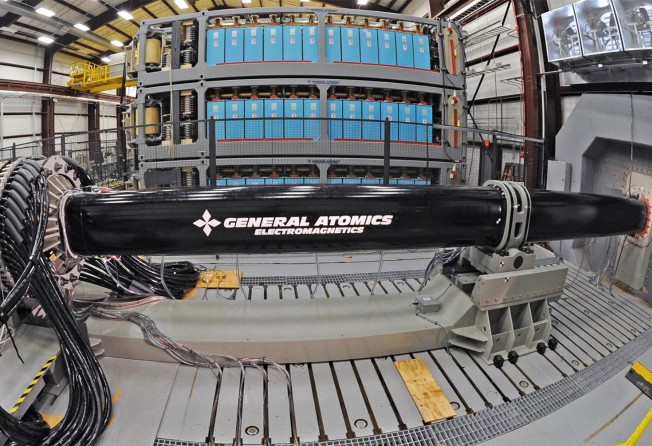
Japan targets Chinese, North Korean hypersonic missiles with US$56 million railgun plan
- Advanced anti-missile system would be able to fire rounds at over 2,000 metres per second, offering protection against nuclear-capable hypersonic glide weapons
- Development is seen as a countermeasure made ‘out of desperation’ against the advances made by Beijing and Pyongyang

Japan is to add another layer to its defences against incoming missiles with the development of an advanced railgun system, raising suggestions that Tokyo is responding in “desperation” to the advances made by China and North Korea in nuclear-capable hypersonic weapons.
The Ministry of Defence has succeeded in having 6.5 billion yen (US$56.1 million) allocated in the initial 2022 budget proposal for a weapon that is widely regarded as being potent, but also problematic due to the technological advances that will be required. Undeterred, work is under way on the system at the ministry’s Acquisition, Technology and Logistics Agency, with officials hopeful it can be deployed before the end of the decade.
Instead of using a conventional explosive propellant to fire a bullet, a railgun utilises electromagnetic force to launch high-velocity projectiles. The round that is fired does not usually contain an explosive charge, instead relying on the projectile’s speed, mass and kinetic energy to inflict damage on the target.
At present, interceptor missiles have a maximum speed of around 1,700 metres per second, but projectiles launched from an electromagnetic railgun will travel at speeds of more than 2,000 metres per second. That particular challenge has already been achieved, with a prototype Japanese weapon hurling a projectile at a rate of nearly 2,300 metres per second.
“This is basically a countermeasure against hypersonic glide missiles that we are now seeing appearing,” said Kazuto Suzuki, a professor of science and technology policy at Tokyo University.
“Until now, Japan’s missile defence has been on the assumption that China or North Korea would launch a ballistic missile and because the target could be determined, then be prepared to shoot it down,” he said. “But hypersonic glide weapons have changed that because they behave differently, meaning that Japan’s existing missile defences could not shoot them down.”

Hypersonic weapons, which travel at more than five times the speed of sound, can manoeuvre in flight, making them far more difficult to intercept. The weapons, which can be fitted with nuclear warheads, are close to being deployed by a number of nations, with China reportedly testing a system over the South China Sea last year. North Korea meanwhile has claimed the missile it launched on January 5 was a hypersonic weapon that “precisely” hit a target nearly 700km away.
No system has yet been devised that is capable of destroying an inbound hypersonic missile.
“Japan sees the railgun as the best solution to this threat,” Suzuki said.
Garren Mulloy, a professor of international relations specialising in security issues at Daito Bunka University, in Saitama prefecture, said there were benefits to a railgun, but also drawbacks.
“One of the major benefits is that a railgun fires a very dense projectile, very far and very fast,” he said.
In addition, the weapon provides a shorter time to target and is impacted less by wind drift, while projectiles can be smaller and lighter but still have the same impact as a conventional round due to the speeds at which they travel. Projectiles are also solid and therefore easier and cheaper to produce.
We now have a completely new threat to deal with – and the railgun plan is out of desperation
There are, however, a number of technological issues that developers need to overcome before a railgun could be deployed, he said. Wear and tear on the system’s barrel and rails is extremely high, meaning that replacements are required regularly, while ensuring the projectile hits a similarly fast-moving target is also proving to be a challenge.
Perhaps the biggest hurdle that needs to be overcome is the enormous amounts of energy that a railgun requires to function, with tests indicating that the weapons required around 25 megawatts of power to operate.
Mulloy suggested that the energy required to operate a railgun was equivalent to that consumed by a small town, meaning that each unit would potentially need power on a scale that could only be provided by a nuclear reactor. On a Japanese warship, that could prove to be a significant problem.
“For many years, Japan has been spending huge amounts of money on missile defence, but the arrival of hypersonic weapons means that we now have a completely new threat to deal with – and the railgun plan is out of desperation,” Suzuki said.
On the positive side, he said, private Japanese technology companies were among the most innovative and advanced in the world and many already have experience in areas that will help in the development of a domestic railgun.
